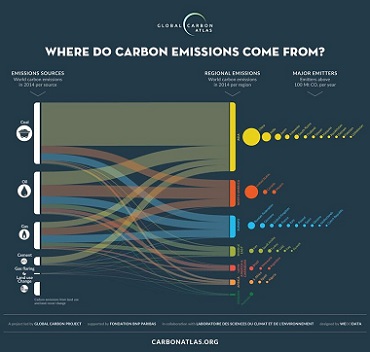River subbasins more depleted than
official figures show
09 April 2024
Published online 7 December 2015
Global emissions of CO2 may be unexpectedly slowing down worldwide, but some Arab states are seeing rapid rise.

© CARBONATLAS.ORG
Enlarge image
Researchers at the University of East Anglia (UEA) in the UK and the Global Carbon Project this week released their 10th update of the yearly Global Carbon Budget, which assesses global CO2 emissions trends worldwide.
The study is published in the journal Nature Climate Change with detailed data simultaneously available in the journal Earth System Science Data and presented during a press conference at the COP21 meeting in Paris.
The 2014 figures and the projections for 2015 are much smaller than the 2.4% growth that was the norm over the past ten years. This decrease is mainly driven by a decrease in China’s reliance on coal, coupled with a strong shift to renewable energies worldwide.
The projections for 2015 are an estimate and Corinne Le Quéré, director of the Tyndall Centre at UEA who led the data analysis, emphasizes that there was always a degree of uncertainty. Her team provided a narrow range from a global decline in emissions of up to 1.5% to a rise of 0.5 percent at the other end of the spectrum to allow for this.
Projection data for 2015 for the Middle East has not been released yet, but there were varying trends in 2014 across Arab states..
In Iraq and Syria, emissions have declined by 0.9% and 0.8% respectively, which may be a result of a slowing down of economic growth caused by war.
While most of the Gulf countries' emissions continue to grow, two GCC countries bucked the trend. Bahrain emitted 25.5 million tons of CO2 in 2014, 0.4% less than in 2013, and Oman's emissions declined by 0.5% in 2014 from the previous year.
Steve Griffiths, vice president for research at Masdar Institute in Abu Dhabi, UAE, was not surprised that those Gulf countries' emissions differ from their neighbours, because of their different economic structure and activity.
“Prior to the major and sustained downturn in oil prices from 2014 onward, economic growth and related consumption was much more robust in the major hydrocarbon exporting GCC countries,” he explains. Economic growth, along with a reliance on fossil fuel energy naturally results in emission increases.
Jordan's emissions also fell by 0.9% between 2013 and 2014. Besides its dependence on imported fuel, which makes it an expensive commodity and dampens use, the country is also one of the regional leaders in renewable energy deployment, which had an impact on its emissions reduction.
Saudi Arabia is by far the largest CO2 emitter in the region, and ranks 9th globally, with emissions reaching 601.9 million tonnes (Mt) in 2014, an increase of 7.7% on 2013.
In per capita emissions, Qatar takes the lead, with 45.9 tonnes CO2 per capita per year. It is followed by Kuwait and UAE, with 27.1 tonnes and 21.8 tonnes CO2 per capita respectively.
In comparison to the world's average CO2 emission per capita which was 4.9 tonnes of CO2 per capita in 2014, Qatar was 829% above the global average, with Kuwait at 449%, the UAE at 342% and Saudi Arabia at 295%.
Outside the GCC region, Egypt emitted 237.4 million tonnes of CO2 in 2014. The country is the 25th biggest emitter worldwide, the second largest in the Middle East after Saudi Arabia and the biggest emitter in Africa. However, Egypt’s per capita levels remain well below global averages at 2.7 tonnes per capita.
Le Quéré is reluctant to predict that this global decrease in emissions will continue beyond 2015. “The energy needs of growing economies still primarily rely on coal and emission decreases in some industrial countries are still modest at best.”
doi:10.1038/nmiddleeast.2015.233
Stay connected: